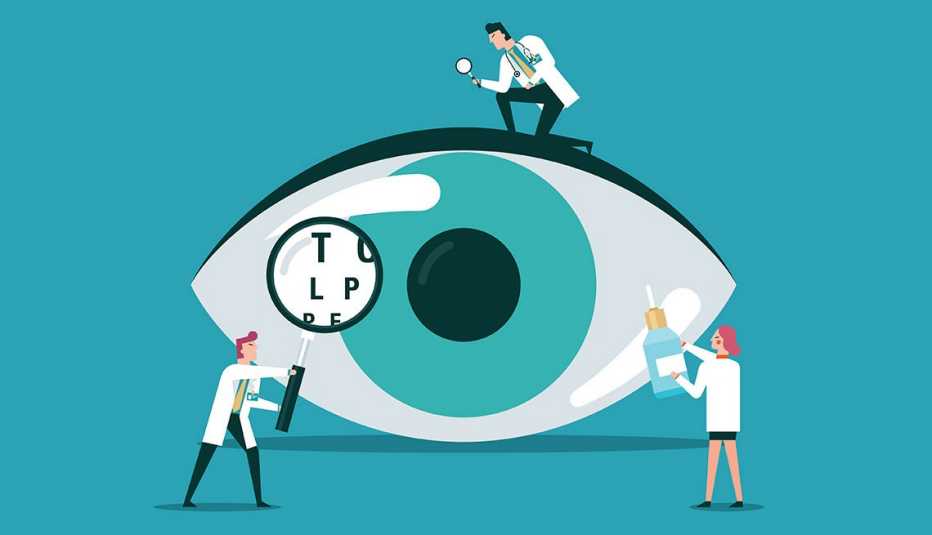Staying Fit


The importance of an annual eye exam cannot be overstated. Not only does it help you keep tabs on any changes in your vision, but it’s a must for detecting the big vision thieves: glaucoma, cataracts and age-related macular degeneration (AMD), all of which can cause irreparable harm before you’ve even noticed any vision loss, says Michelle Andreoli, M.D., an ophthalmologist at Northwestern Medicine and a spokesperson for the American Academy of Ophthalmology.
What might not be so obvious when it comes to the health of your eyes are the everyday habits that affect them. Here are eight of the worst habits for eyes — and what you can do to break each of them.


AARP Membership— $12 for your first year when you sign up for Automatic Renewal
Get instant access to members-only products and hundreds of discounts, a free second membership, and a subscription to AARP the Magazine.
Bad habit 1: Smoking
Add this to the always-growing list of reasons to give up smoking for good: Cigarette smoke is more than just irritating to your eyes; research shows it also raises your risk of developing AMD, the eye disease that can blur your central vision. People over age 55 are already at risk for the condition, but a large review of studies published in Clinical Interventions in Aging shows that smokers are at a twofold to fourfold risk of AMD, as compared to never smokers.
“Smoking reduces the effectiveness of antioxidants and may deplete these levels in the macula,” the small area at the center of the retina that’s necessary to see things in front of you, explains Ashley Brissette, M.D., an ophthalmologist and assistant professor of ophthalmology at Weill Cornell Medicine in New York City. “Cigarette smoke also reduces the amount of oxygen reaching the tiny blood vessels that supply the eye, leading to vision damage.” That’s true for those who smoke only occasionally or are regularly exposed to secondhand smoke, Brissette adds. The good news? The same review of studies shows that kicking the habit not only reduces the risk of AMD, but after 20 years, the risk of developing the condition is the same as it is for nonsmokers.
Bad habit 2: Staring at your smartphone
Your eyes pay a price directly and indirectly when you stare at that tiny screen — or, for that matter, your computer screen or TV — without giving them a break. According to the American Optometric Association, using any of your digital devices continuously for two hours is enough to bring about digital eye strain.
“The two biggest concerns with onscreen habits boil down to chronic dry eye symptoms and disruption of natural sleep patterns,” Andreoli says. “We’re supposed to blink once every 4 seconds, and in front of the computer, we blink about once every 8 to 10 seconds. That [difference] may sound insignificant, but blinking is what keeps our eyes lubricated. [If] we aren’t lubricating our eyes sufficiently, we develop dry eye symptoms, and that leads to eye strain.” Then there’s the toll too much screen time takes on our sleep patterns. “The brightness of the screen and the activity tells our brain it’s daytime, so we have a tendency not to get appropriately tired,” Andreoli says.
Her recommendation: Practice the 20-20-20 rule. Throughout the day, take a 20-second screen break every 20 minutes to look at something 20 feet away. And while you’re in the habit-changing mode, turn off your phone and put the laptop away in the hours leading up to bedtime. If you like to play, say, Wordle or return emails late at night, be sure to dim the screen’s brightness. You can schedule this to happen automatically using the Night Shift setting on an iPhone or Notification Shade on an Android.
Bad habit 3: Not wearing sunglasses
In the same way that ultraviolet (UV) radiation from the sun can do a number on your skin, it can also wreak havoc with your vision. Specifically, UV rays can damage the eye’s surface tissues, the cornea and lens. And over time, that damage can lead to cataracts, AMD and cancers of the eye.
“You can also develop a sunburn on the eyes called photokeratitis, which can be extremely painful,” Brissette says. To help prevent all of the above, wear sunglasses — and not just during the summer but every day of the year, even when it’s cloudy. “Sunglasses protect the eyes in a few ways,” Brissette adds. “It’s hard to apply sunscreen close to the eyes, so sunglasses can act as a physical barrier, blocking UV rays from the eyelids and skin around the eyes. Also, the lenses of the sunglasses have UV protection.” To fully protect your eyes, check the tag or sticker to make sure the glasses provide 100 percent UV protection. “Some labels say, ‘UV absorption up to 400 nm,’ which is the same as 100 percent UV protection,” Brissette says.
Worth noting: Even if you wear contact lenses with UV-blocking technology, you should still wear sunglasses outdoors. According to the American Academy of Ophthalmology, these contacts protect only the part of the eye they cover, leaving the outside of the eye exposed to harmful radiation. Your eyes get the most protection when you wear sunglasses, especially wraparound styles.




































































More on Eye Health
4 Types of Eye Drops and How to Use Them Safely
These can help with dryness, redness, allergies and irritation
6 Best Vitamins for Eye Health
Find out which nutrients are essential for protecting vision
The 10 Best Superfoods for Your Eyes
Protect your vision with these nutritious (and delicious) foods